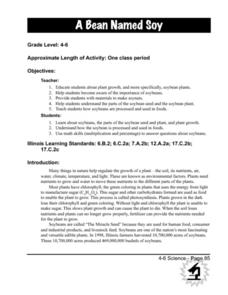Curated OER
The Carbon Cycle
In this carbon cycle worksheet, learners will read about the carbon cycle and study a diagram showing what creates carbon dioxide and what uses carbon dioxide. Students will then complete 4 short answer questions.
Curated OER
Sunken Millions Animals
This PowerPoint includes a game with ocean graphics in which two teams answer increasingly difficult questions about animals. Topics covered include plant and animal cells, animal adaptation, and similarities and differences between...
Curated OER
Measurement of Biotic and Abiotic Objects
Students identify biotic and abiotic factors. In this environmental study lesson, students conduct a series of experiments to collect and record data and draw conclusions based on the results.
Curated OER
Models as Tools for Ecosystem Management
Fifth graders explore the concept of environmental management. In this ecosystem instructional activity, 5th graders discover how models help scientists learn more about managing ecosystems. Students create their own model, make...
Curated OER
pH Potential
Students experiment to determine the positive and negative impacts of human activities on environmental change. They examine how physical and biological processes such as decomposition affect soil characteristics while looking at the pH...
Curated OER
A Demonstration of Photosynthesis and Transpiration
First graders examine the effect that light and air has on green plants.
Curated OER
Sun and Shade
Young scholars explore the ways that plants adapt to their environments. They examine plants that thrive in the shade, versus plants that thrive in direct sunlight. Special attention is devoted to the shape of leaves on respective sun...
Curated OER
Squanto's Science Lesson
Students explore Squanto's contribution to the settlers. They plant seeds and follow instructions for water and fertilization. Students keep a record of the growth of the seeds. They write a paragraph that tells what they learned from...
Curated OER
Photo Synthesis and Transpiration
Students germinate pea seeds and plant the seeds. They experiment with different amounts of light and darkness on the plant growth.
Curated OER
Our Earth Crossword Puzzle
In this earth's environment worksheet, learners use the 20 clues and their problem solving skills to correctly complete the crossword puzzle.
Curated OER
The Root Show
Students investigate plant roots. In this plant activity, students discover the function and structure of plant roots. Students plant a plant in a milk carton with a clear section cut out in order to observe the roots of the plant.
Michigan Sea Grant
What's in This Water?
Pupils investigate the biological and chemical characteristics of water to determine where purple loosestrife occurs. They create data sheets to record water quality tests in several locations and work in groups to conduct the water...
Curated OER
Soybeans: The Miracle Seed
Students discover why soybeans are called the "miracle seeds." They make their own soynuts and share other foods made from soybeans. They create a bulletin board of soybean products.
Curated OER
The Three Sisters
Students read about the Three Sisters of the crops that helped the Native Americans and plant a garden based on companion planting. In this crops lesson plan, students complete garden designs and then create their garden.
Curated OER
Renewable vs. Non-Renewable Resources
Here's a fine lesson plan on renewable and non-renewable sources of energy for your 5th graders. In it, learners list a number of natural resources on the board, then try to sort the resources into appropriate categories. This helps them...
Curated OER
Food chains and webs
Here is an extremely simplistic look at food chains and webs. It depicts three different food chains, each containing a plant, plant eater, and meat-eater. Learners fill in the missing part of each chain by using the images provided at...
Curated OER
Physical Changes Pre-Quiz
Quiz the class on what they know before you teach it. This assessment will give you an idea of what basic scientific concepts are known to your learners. Physical change, state of matter, and basic plant and animal needs are covered.
Curated OER
Habitats: must live with them....cannot live without them.
Young scholars conduct an internet study regarding habitat, ecosystem, biome and the region they live in. They observe the habitat by visiting a State Park and observing the organisms in their habitat. In addition, they create their own...
Curated OER
The good microbes
The question posed for the class to consider; What would decay and what would not? They read the short passage on decomposition and microbes, then mark the items that would decay after a two-week period. A scientific investigation idea...
Curated OER
Native Beauty
Students plant wild flowers and maintain their garden. In this wild flowers lesson plan, students pick and prepare a gardening site, plant wild flowers, and maintain it everyday.
Curated OER
Biochemical Cycles
When learning about several different processes at a time, it can be difficult to differentiate between them. In the resource found here, you can see what your kids know about some of Earth's systems including the carbon, hydrologic,...
Curated OER
Bud the Spud Moves West
As part of a unit on Canadian agriculture, this focuses on how potato farms have increased in the west. Pupils participate in a discussion about the impact of consumer demand on production, and then they read an article about potato...
Curated OER
Poisoning the Prairie
Seventh graders investigate what pesticides are and why people use them. They examine the effect of pesticides on prairie grasses and what alternatives can be used.
Curated OER
Planting Rabbit King’s Carrot
Even pirates know not to steal stuff you can make yourself! Read The Pirate's Parrot Stole the King's Carrot to engage your class. Then, plant carrots with your class. If this isn't possible with your kiddos, consider cutting out paper...























